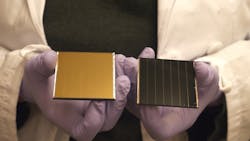Chlorine offers better stability for next-generation solar cells
Imaging atoms on the surface of the light-absorbing layer of next-generation solar cells is helping researchers find resolution to a long-standing debate in the solar technology research realm regarding the role and presence of chlorine.
Led by Yabing Qi, a professor in the Energy Materials and Surface Sciences Unit at Okinawa Institute of Science and Technology Graduate University (OIST) in Japan, a team of researchers has demonstrated the power-boosting, stability-enhancing properties of chlorine when incorporated into metal-halide perovskite—a crystal material that harvests light in next-generation solar cells. Metal-halide perovskites could surpass, or potentially complement, existing solar cells consisting of silicon.
“Perovskites have the potential to be cheaper, more efficient, and more versatile than silicon,” says Dr. Afshan Jamshaid, a former Ph.D. student in the OIST Energy Materials and Surface Sciences Unit, who led the study. A downside, he noted, is that perovskite solar cells “suffer from issues with efficiency, up-scaling, and stability, holding them back from commercialization. High temperatures, humidity, and UV light can degrade the perovskite material, reducing how well it can convert light energy to power.”
Researchers have long worked to overcome such issues, including improving perovskite solar cells with the use of dopants (small traces of another chemical that are added during the process of making the perovskite crystal layer). According to the OIST study, these dopants—such as chlorine—can change the physical and chemical properties of the perovskite material, and in turn boost the stability and efficiency of a solar cell. Specifically, chlorine has increased the lifespan of perovskite solar cells and can enhance their power conversion efficiency.
In their study, the researchers created thin films of the metal-halide perovskite—methylammonium lead iodide—doped with chlorine. Scanning tunneling microscopy was employed to image the surface of the perovskite layer. The team has found that “the optimal concentration of chlorine in the surface layer of the perovskite material” is just under 15%, which provides higher stability. Reference: A. Jamshaid et al., Energy Environ. Sci., 14, 4541–4554 (2021).
About the Author
Justine Murphy
Multimedia Director, Digital Infrastructure
Justine Murphy is the multimedia director for Endeavor Business Media's Digital Infrastructure Group. She is a multiple award-winning writer and editor with more 20 years of experience in newspaper publishing as well as public relations, marketing, and communications. For nearly 10 years, she has covered all facets of the optics and photonics industry as an editor, writer, web news anchor, and podcast host for an internationally reaching magazine publishing company. Her work has earned accolades from the New England Press Association as well as the SIIA/Jesse H. Neal Awards. She received a B.A. from the Massachusetts College of Liberal Arts.

